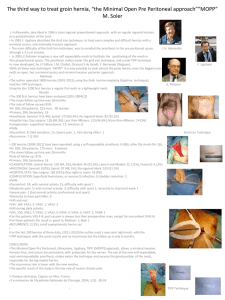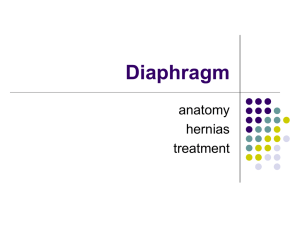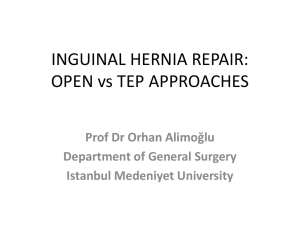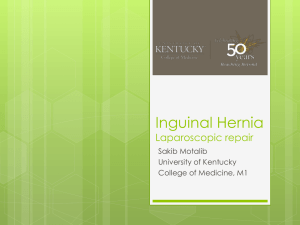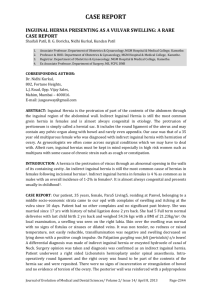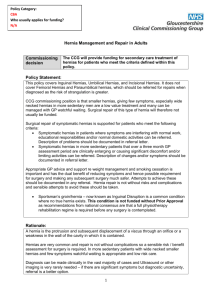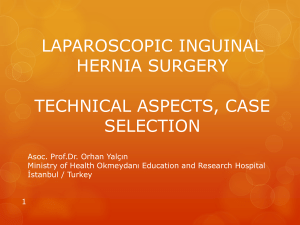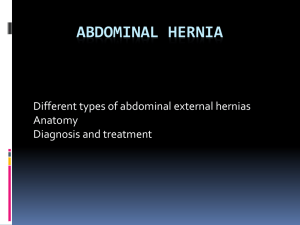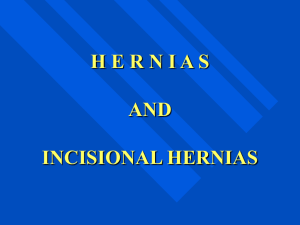Hernias
advertisement
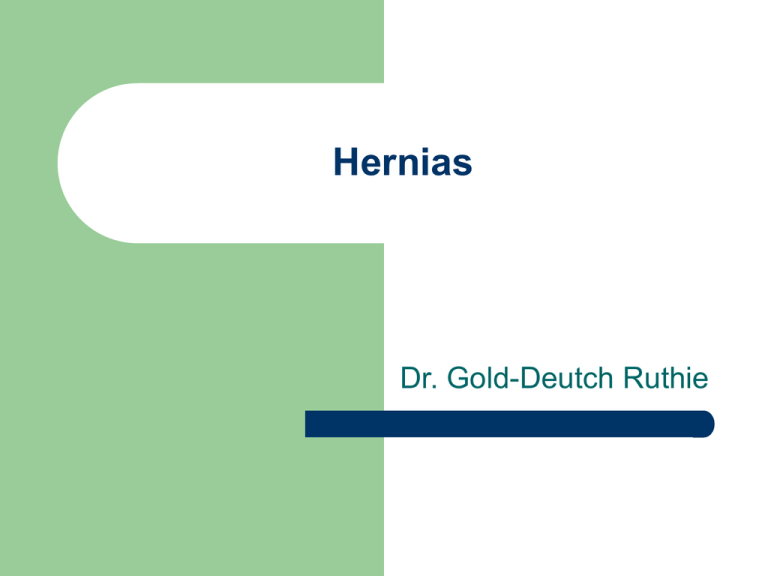
Hernias Dr. Gold-Deutch Ruthie Hernia Protrusion of abdominal viscera outside the abdominal cavity through a natural or acquired defect (not include internal hernias). Inguinal hernia True incidence of inguinal hernia is not known. overall incidence in adults 10-15 % male / female ratio 12 : 1 25 – 40 years old 5–8% over 75 years old > 45 % Children 10- 20 per 1000 live births High incidence in premature infants male / female ratio 4:1 Almost all are indirect hernias Direct hernias < 1% Etiology Presence of a preformed sac Patent processus vaginalis prime cause of indirect hernia in infants and children Repeated elevations in intra-abdominal pressure COPD- coughs BPH Constipation / colonic obstruction Strains Pregnancy Ascites Peritoneal dialysis Ventriculo-peritoneal shunt Etiology (cont’) High intra-abdominal pressure Weak areas -Ttransversalis fascia Internal inguinal ring Direct hernia Weakening of the body muscles and the tissues with time lack of physical exercise, adiposity, multiple pregnancies, loss of weight as may occur after illness or operation. Multifactorial Abnormalities in the structure of collagen - (recurrent hernias, familial tendency) Clinical manifestations Present at birth or appear afterward In adults – more insidious (rapid onset – “acute” indirect hernia following an unusual exertion) Discomfort in the groin, small bulge crease when intra-peritoneal pressure raises - reduces when patient lies down - Reducible hernia Patient learns to reduce it manually Early stages – pain Later - unaesthetic bulge of the groin and scrotum interferes daily activities and causes a heavy dragging sensation Adhesions between the sac and content - Irreducible hernia Incarcerated hernia Strangulated hernia Examination Bulge that increases in size with coughing and can be reduced in supine position (gurgling sound) Small hernias – when the patient stands, a cough impulse can be felt at the tip of the finger, introducing it into the inguinal canal through the external ring by invaginating the scrotum. Differentiation between indirect and direct hernias is of academic interest only The true nature of the hernia is revealed at operation and is handled accordingly. Incarcerated / strangulated - tense, swollen, tender, red, edematous, inflamed Indications for operation Risk of hernia operation is negligible, recurrence rate is small that there is hardly any reason not to operate all hernias as soon as they are diagnosed. Elderly patient should be operated on electively because of the associated medical problems, rather than citing these problems as causes for not operating. Bassini repair Shouldice repair Lichtenstein’s (tension free) repair – polypropylene mesh Mcvay (cooper’s ligament) repair Laparoscopic repair – TEPA - Totally Extra-Peritoneal Approach TAPP - Trans-Abdominal Pre-Peritoneal repair Complications - Systemic complications – urinary retention Local complications – wound - hematoma, seroma, infection scrotum and cord – swelling, hematoma Ischemic orchitis Testicular atrophy cut vas deferens Ilioinguinal neuritis Open herniorrhaphy - Ilioinguinal n. + Iliohypogastric n. Laparoscopic repair - Lateral femoral cutaneus n. (Meralgia Paresthetica - pain and paresthesias in anterolateral thigh) + genitofemoral n. Recurrence – indirect hernia direct hernia recurrent hernia - 1-7% 4 - 10 % 5 – 35 % Kinds of hernias Inguinal hernia Femoral hernia Umbilical hernia Epigastric = Supraumbilical hernia POVH – post operative venteral hernia Spigelian hernia Hiatal hernia Lumbar hernias Perineal hernias Obturator hernia Paracolostomy = para stomal hernia Littre’s hernia Maydle’s hernia Internal hernia Richter’s hernia Sliding hernia Sliding Hernia Sliding Hernia is defined as one in which a viscus makes up part of the wall of the hernial sac.

